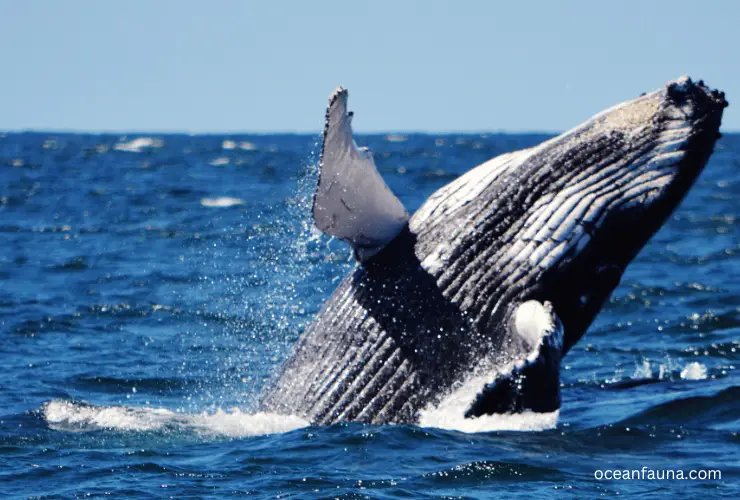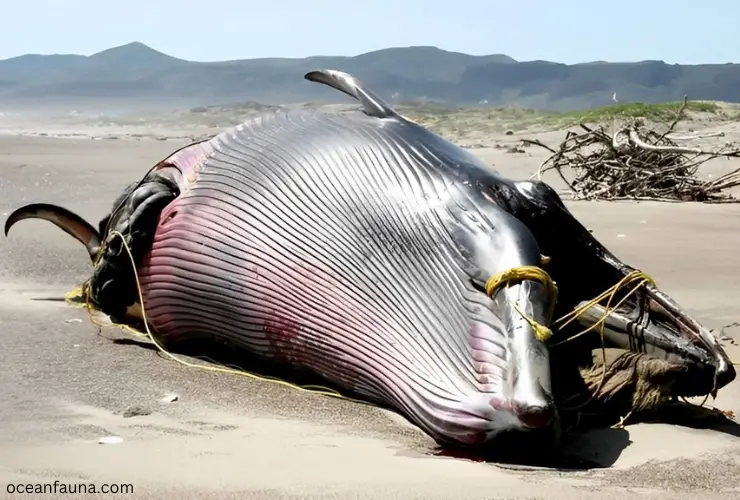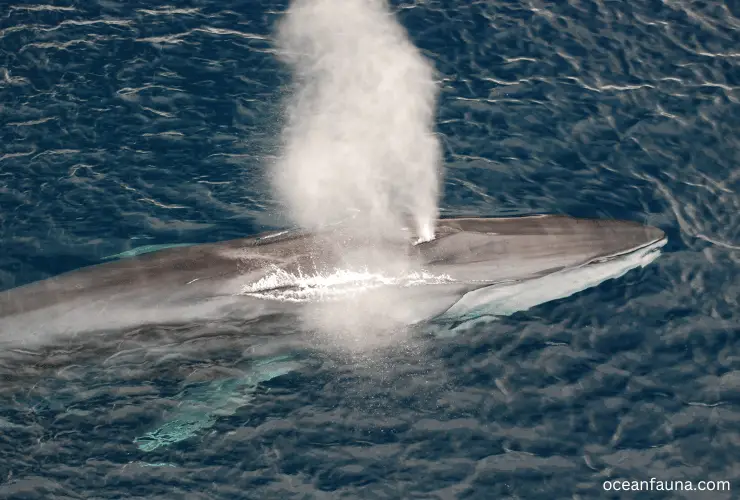Death is the ultimate stage of all lives. Whales are no exception. Now, the question is, how do most whales die? In short, most whales die a natural death in old age. However, in recent reports, it has been found that humans are causing many whales to die prematurely.
In this blog, I will discuss all the reasons for whales’ deaths, including necessary conservative precautions to protect whales.
How Do Most Whales Die?

How do whales die? Whales mostly die due to a range of factors, both natural and human-induced. Natural causes include old age, diseases, and predation by killer whales, polar bears, or sharks. Conversely, human activities such as fishing, ocean shipping, oil exploration, and drilling have progressively impacted their mortality rates.
Let’s have a more detailed overview of each cause.
3 Natural Causes
How do most whales die naturally? Here are three natural causes.
Old Age
Like all creatures, whales age. Their life spans vary, with some species living 60 to 100 years. Aging whales become more prone to diseases and infections, which often lead to death.
Diseases
Whales, just like humans, can contract various diseases. These may include bacterial or viral infections, fungal diseases, parasites, and cancers. Many times, these diseases are a result of exposure to polluted waters or toxins in their food.
Predation
Despite their size, whales are not safe from predators. Killer whales, or orcas, are top predators. They sometimes hunt other whale species. In the Arctic, polar bears are significant predators and can kill whales. Great White Sharks are also known to prey on whales.
7 Human Activities
Which human activities cause most whales to die? Here are seven human-induced causes:
Bycatch: The Leading Human-Caused Death
Bycatch, unintentional capture in fishing nets, is the leading human-caused death for whales. This harms whales and disrupts the ocean’s food chain and ecological balance.
Entanglement in Fishing Gear
Whales often get entangled in fishing gear. This can lead to severe injuries, drowning, or hinder their feeding, swimming, and socializing.
Hunting
Although reduced, whale hunting continues in some countries, greatly harming populations, especially those already at risk from past overhunting. A global moratorium on commercial whaling has been in place since 1986.
Vessel Strikes
Ship collisions, a form of human interaction, also cause many whale deaths. These incidents, often in busy shipping lanes or near ports, lead to severe injuries or death, especially for fast-swimming species.
Oil Exploration and Drilling
Oil drilling activities cause noise pollution and disrupt whale communication, feeding, and mating. Additionally, oil spills expose whales to harmful pollutants, leading to health issues and death.
Plastic Pollution
Plastic pollution in the oceans is a significant threat to whales. Ingesting microplastics into their food, they suffer from digestive blockages, altering feeding habits and causing starvation or death.
Global Warming
Global warming poses a growing threat to whales. Rising temperatures, changing ocean chemistry, and habitat loss make finding food and reproducing difficult, threatening their survival.
Do Most Whales Die from Drowning?

No, most whales don’t die from drowning. Whales are adapted to live underwater and can hold their breath for long. They’re built to handle sea pressure and temperatures, letting them dive deep for food. But whales can sometimes suffocate.
Whales can get trapped in fishing nets and lines, which stops them from surfacing to breathe. This is riskier for sick or weak whales that might lack the strength to escape. Another suffocation risk is when they collide with ships and vessels.
If ingested, marine debris like plastic bags and fishing lines can also cause suffocation. If objects like plastic get stuck in their throats, they can block oxygen flow and lead to suffocation. And this suffocation may cause them to die.
So, while drowning isn’t common, whales face other risks that can prevent them from breathing.
Where Do Dead Whales Go?

When a whale dies, its body sinks to the ocean’s bottom. It forms the base of a rich ecosystem called a ‘whale fall.’ Whale falls provide vital nutrients and energy for many deep-sea creatures. These include big scavengers like sharks and crabs and even tiny bacteria.
In this process, different organisms feed on the whale at various stages. Each stage lets different creatures gain nutrition from the carcass. As the whale decomposes, smaller scavengers like crabs and squid reach its softer tissues and bone marrow. Besides giving nutrients to deep-sea creatures, whale falls also link different parts of the ocean ecosystem.
Sharks and other predators eat the whale’s flesh. Their waste releases nutrients into the water. This helps plankton and tiny organisms grow. Filter-feeding animals like mussels and clams are attracted to these. They, in turn, become food for larger predators.
Why Do People Hunt Whales?
People hunt whales for different reasons. One main reason is for commercial use. They use whale meat, oil, and fat in various products. In some countries, there’s a high demand for these whale parts. They make candles, soaps, and medicines from them.
Whale oil, for example, was once popular in high-end cosmetics. But as more people support whale conservation, its use is decreasing. Another reason for whale hunting is cultural. In some cultures, whale hunting has been a tradition for centuries. For example, the Greenlandic Inuit have hunted whales for food and oil for decades. It’s a key part of their lifestyle.
In Japan, whale hunting is part of the cultural heritage, often celebrated in poetry and song. But even there, support for whale hunting is declining, and it’s now banned commercially.
Some people also hunt whales for scientific research. Many agree that killing whales isn’t needed for research. Yet, some groups claim it helps manage whale populations. However, this view is challenged by evidence showing non-lethal research methods are effective.
Despite these reasons, whale hunting is controversial. Many countries are working to protect whales, and laws against whale hunting are strengthening. Yet, enforcing these laws can be tough. In some places, whales are still hunted for profit, putting them at risk. Protecting these majestic creatures remains a vital global issue.
Sadly, many whale species are endangered because of human actions like hunting and pollution. The International Union for Conservation of Nature (IUCN) lists several at-risk species. This includes rice whales, sea whales, North Atlantic right whales, and blue whales.
Rice whales
Rice whales, or North Pacific Right whales, are critically endangered, the most among whale species. They were almost wiped out in the 19th century. Only about 30 Rice whales are left, making them one of Earth’s rarest mammals.
Sei whales
Sei whales are more abundant but are still listed as endangered. Found in all oceans except the Arctic and Antarctic, they face threats like entanglement in fishing gear and ocean noise pollution. Despite being hunted in Japan, their population shows a slight increase.
North Atlantic Right whales
North Atlantic Right whales are also in severe danger. About 400 are left, mostly in the North Atlantic. Their numbers are dropping fast. Ship collisions, fishing gear entanglement, and noise from ships and industries are big threats.
Blue whales
Blue whales, the largest animals on Earth, face some risks. Once hunted to near extinction, their numbers are now around 10,000. They remain endangered due to pollution, climate change, and fishing gear entanglement. Protecting these majestic creatures is crucial for their survival.
Conservation for Whales

Despite the grim future facing many whale species, there’s still hope. Conservation efforts are gaining ground. More countries are pledging to safeguard these majestic creatures. Agreements like the Convention on Migratory Species (CMS) offer governments a way to protect whales and other sea mammals.
Also, numerous non-governmental organizations are fighting for whale protection. They advocate for these gentle giants and work towards their safety.
Groups like the WWF and Greenpeace work to make people aware of whales’ struggles. They lobby governments for stronger whale protections. These efforts include public education campaigns, which are vital in boosting support for whale conservation.
Raising awareness about whales helps us unite to prevent their extinction. Together, we can ensure these magnificent animals thrive for generations to come. Conservation for whales is not just about saving a species but preserving the balance of our marine ecosystems.
FAQs
Who kills the most whales?
Norway has been responsible for the highest number of whale killings, with approximately 500-600 whales being hunted each year for their meat and blubber. As per a report, In 2022 alone, around 580 whales were killed in Norway. Since the establishment of the moratorium in 1986, this country has hunted over 15,000 whales.
Why should whales not be killed?
There are compelling reasons to oppose the killing of whales. The primary objection to whale hunting is rooted in its inherent cruelty, inflicting intolerable pain and suffering upon the targeted animals.
Additionally, when conducted on a large commercial scale, it poses a significant threat to the survival of numerous species, pushing some to the precipice of extinction.
Conclusion
Now you have a detailed knowledge of whale death. Human activities are one of the main reasons why whales are endangered today. It is a must to be aware of these majestic creatures’ threats and take action to protect them.
Conservation efforts, such as those undertaken by international organizations, are essential for ensuring a future where whales can thrive in their natural habitats.

